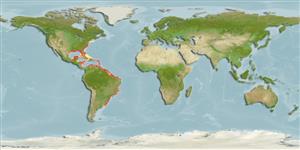>
Carangiformes (Jacks) >
Carangidae (Jacks and pompanos) > Trachinotinae
Etymology: Trachinotus: Greek, trachys, -eia, -ys = rough + Greek,noton = back (Ref. 45335).
More on author: Linnaeus.
Environment: milieu / climate zone / Tiefenbereich / distribution range
Ökologie
seewasser; brackwasser benthopelagisch; ozeanodrom (Ref. 51243); tiefenbereich 1 - 70 m (Ref. 9626). Subtropical; 43°N - 38°S, 97°W - 35°W (Ref. 44847)
Western Atlantic: Massachusetts, USA through the Gulf of Mexico and scattered localities in the West Indies (Ref. 26938) to Brazil. Also found in Argentina (Ref. 44847). Absent from clear waters of Bahamas and similar islands (Ref. 7251).
Length at first maturity / Size / Gewicht / Alter
Geschlechtsreife: Lm ?, range 25 - ? cm
Max length : 64.0 cm TL Männchen/unbestimmt; (Ref. 7251); common length : 40.0 cm TL Männchen/unbestimmt; (Ref. 5217); max. veröff. Gewicht: 3.8 kg (Ref. 40637); max. veröff. Alter: 7 Jahre (Ref. 125592)
Adults occur in coastal waters, commonly entering bays and estuaries. Juveniles found in sandy beaches exposed to wave action (Ref. 5217). Adults are absent from insular areas with coralline habitats (Ref. 5217). They generally form small to large schools. They feed on mollusks, crustaceans and other invertebrates and small fish. Excellent food fish (Ref. 9626). Highest priced marine food fish in the USA (Ref. 171). Have been reared in captivity (Ref. 35420).
Robins, C.R. and G.C. Ray, 1986. A field guide to Atlantic coast fishes of North America. Houghton Mifflin Company, Boston, U.S.A. 354 p. (Ref. 7251)
IUCN Rote Liste Status (Ref. 130435: Version 2025-1)
Bedrohung für Menschen
Harmless
Nutzung durch Menschen
Fischereien: hoch kommerziell; Aquakultur: kommerziell; Sportfisch: ja; Aquarium: Öffentliche Aquarien
Tools
Zusatzinformationen
Download XML
Internet Quellen
Estimates based on models
Preferred temperature (Ref.
123201): 23.3 - 28, mean 25.6 °C (based on 454 cells).
Phylogenetic diversity index (Ref.
82804): PD
50 = 0.5000 [Uniqueness, from 0.5 = low to 2.0 = high].
Bayesian length-weight: a=0.01585 (0.00898 - 0.02799), b=2.82 (2.67 - 2.97), in cm total length, based on LWR estimates for this species & Genus-body shape (Ref.
93245).
Trophic level (Ref.
69278): 3.5 ±0.6 se; based on diet studies.
Widerstandsfähigkeit (Ref.
120179): mittel, Verdopplung der Population dauert 1,4 - 4,4 Jahre. (Assuming tm=2-4).
Fishing Vulnerability (Ref.
59153): Low to moderate vulnerability (27 of 100).
🛈
Climate Vulnerability (Ref.
125649): High to very high vulnerability (69 of 100).
🛈
Nutrients (Ref.
124155): Calcium = 57.7 [29.8, 115.8] mg/100g; Iron = 0.97 [0.54, 2.04] mg/100g; Protein = 18.8 [16.7, 20.8] %; Omega3 = 0.281 [0.153, 0.553] g/100g; Selenium = 30.8 [15.2, 64.5] μg/100g; VitaminA = 7.89 [2.08, 26.10] μg/100g; Zinc = 0.721 [0.478, 1.101] mg/100g (wet weight);
